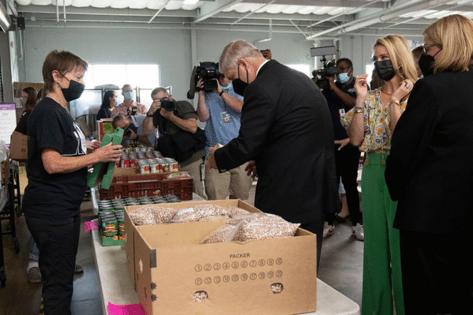Many farmworkers go without food in California. How Yolo County's food bank fights hunger
Published in News & Features
SACRAMENTO, Calif. — In Yolo County, where agriculture generates nearly a billion dollars a year, the food bank is attempting to solve an uncomfortable irony: More than half of farmworker households struggle with food insecurity.
So, the Yolo Food Bank with researchers at Sacramento State University and other groups studied the barriers keeping agricultural workers from food and how the food bank could use its resources to overcome them.
They devised food distributions that meet farmworkers right where they are, whether it’s after work at multifamily residences or in the fields as they prepare to leave work.
The targeted food drops eliminate many of the transportation, time and trust barriers agricultural workers have said kept them from accessing such support. Not all food banks take the steps needed to overcome such systemic barriers, one farmworker advocate said.
Yolo County Supervisor Lucas Frerichs joined food bank volunteers last week to kick off the second year of the program, dubbed Cultivo, in Winters. He contributed $20,000 from his district’s community benefit funds toward the program, which takes its name from the Spanish word for crop.
“I hope others across Yolo County — individuals, businesses and organizations — will join the effort to support our essential agricultural workforce,” Frerichs said.
A pressing need in California’s fields
The numbers are sobering: 53% of farmworker households in Yolo County experience food insecurity, according to the Yolo Food Bank’s Food Access Survey Report.
While the county is widely known for its abundant tomato, almond and rice crops, it’s also the most impoverished of California’s 58 counties under the California Poverty Measure.
Farmworkers, most of whom are immigrants or permanent residents with deep roots in the community, earn low wages — typically around $20,000 per year. At the same time, they face some of the highest housing and utility costs in the region.
Many report skipping meals to pay rent. Others share crowded living spaces, forgo medical care, or ration food for their children. Although 41% of farmworkers live in extremely low-income households, according to Yolo County data, only a small portion access public benefits such as CalFresh or the Women, Infants and Children nutritional program due to fear, stigma, or lack of information.
The strength of Cultivo lies in its logistical precision and community-based approach. Yolo Food Bank said its staff and volunteers pack food boxes a day or so before the distribution and deliver them in a refrigerated truck. Each household receives fresh fruits, vegetables, proteins, tortillas and culturally significant staples such as rice and beans.
Distributions occur regularly at four sites, but there are additional events scheduled during off-harvest months. Last year, Yolo Food Bank provided 36,000 pounds of food to more than 1,000 households.
The goal in 2025: Reach more than 2,500 households.
Finding those in need is possible with YoloWorks! Agricultural Labor Program, which connects the food bank with farmworker communities.
A tale of two food banks: Yolo vs. Sacramento
The Cultivo model stands in stark contrast to what’s unfolding just a county away in Sacramento.
Farmworker advocate Ramona Landeros said that, for the last two years, she had been going to a food closet that partnered with the food bank to pick up boxes on behalf of dozens of families in Del Paso Heights — many without cars, flexible schedules or trust in formal systems.
But late in March, the informal pickups came to a sudden halt. The Sacramento Food Bank & Family Services said the distributions violated food safety and distribution rules.
Sacramento Food Bank CEO Blake Young said rules set by the organizations donating food require that it distribute only to partner organizations with proper storage facilities.. The food closets and other organizations it partners with, he said, are prohibited from redistributing food to other organizations.
In addition, he said, while individuals may act as proxies, picking up food boxes for up to five people, organizations cannot.
Landeros said she applied to pick up the food boxes as part of her work for her the Benito Juárez Foundation, and notified farmworkers when they could pick up their food boxes from her home on the group’s Facebook page.
The fallout has left many of Sacramento’s farmworker families without consistent access to food, Landeros said. There’s not a rough estimate on the number of farmworkers working and living in Sacramento County, but the region produced roughly $584.8 million worth of crops and livestock in 2023, according to a report by County Agricultural Commissioner Chrisandra J. Flores. The top commodities that year, she noted, included wine grapes, pears, tomatoes for processing and milk.
A program like Cultivo would eliminates guesswork for the people behind the Sacramento County harvest. Instead, farmworkers in Del Paso Heights now face a five- to ten-mile journey to reach a pantry, if they can find one open when their workdays end.
How Yolo Food Bank funds a solution
Sustaining a program such as Cultivo requires funding, coordination and community will. The program was seeded by a $200,000 investment from Sutter Health, which saw an opportunity to address a critical social determinant of health.
Yolo Food Bank, which operates on an annual budget of more than $21 million, spends nearly 90% on food programs and operations. Its funding comes primarily from donated food (68.9%), government support (11.6%), and individual donations (7.2%).
Cultivo’s food is sourced through a mix of Feeding America retail partnerships (62%), purchases (16%), and contributions from local grocers, government agencies, and farms.
“Cultivo’s approach is simple yet powerful: bring fresh, healthy, culturally familiar foods directly to farmworkers where they live and work — eliminating transportation barriers, building trust, and respecting cultural needs that are too often overlooked in traditional food assistance models,” said Karen Baker, executive director of Yolo Food Bank.
Cultivo is designed to overcome specific challenges farmworkers face. According to the food access survey, 27% of food-insecure households believe they don’t qualify for services, and 20.8% don’t know where to go. Additionally, 16.8% said that charitable food rarely or never meets their cultural or dietary needs.
By bringing distributions directly to trusted locations and providing familiar, culturally relevant food, Cultivo builds trust and reduces stigma. And by listening to the community — through surveys, focus groups, and grassroots outreach — it ensures its model remains responsive and relevant.
As climate change continues to drive extreme heat, and the cost of living outpaces wages, the challenges facing Yolo County’s agricultural workers aren’t likely to fade. The Yolo Food Bank is working to sustain a workforce of roughly 7,000 who are crucial to an agricultural industry that feeds people worldwide.
____
©2025 The Sacramento Bee. Visit at sacbee.com. Distributed by Tribune Content Agency, LLC.







Comments